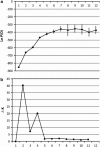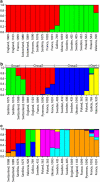DNA polymorphism in recombining and non-recombining mating-type-specific loci of the smut fungus Microbotryum
- PMID: 21081967
- PMCID: PMC3186254
- DOI: 10.1038/hdy.2010.140
DNA polymorphism in recombining and non-recombining mating-type-specific loci of the smut fungus Microbotryum
Abstract
The population-genetic processes leading to the genetic degeneration of non-recombining regions have mainly been studied in animal and plant sex chromosomes. Here, we report population genetic analysis of the processes in the non-recombining mating-type-specific regions of the smut fungus Microbotryum violaceum. M. violaceum has A1 and A2 mating types, determined by mating-type-specific 'sex chromosomes' that contain 1-2 Mb long non-recombining regions. If genetic degeneration were occurring, then one would expect reduced DNA polymorphism in the non-recombining regions of this fungus. The analysis of DNA diversity among 19 M. violaceum strains, collected across Europe from Silene latifolia flowers, revealed that (i) DNA polymorphism is relatively low in all 20 studied loci (π∼0.15%), (ii) it is not significantly different between the two mating-type-specific chromosomes nor between the non-recombining and recombining regions, (iii) there is substantial population structure in M. violaceum populations, which resembles that of its host species, S. latifolia, and (iv) there is significant linkage disequilibrium, suggesting that widespread selfing in this species results in a reduction of the effective recombination rate across the genome. We hypothesise that selfing-related reduction of recombination across the M. violaceum genome negates the difference in the level of DNA polymorphism between the recombining and non-recombining regions, and may possibly lead to similar levels of genetic degeneration in the mating-type-specific regions of the non-recombining 'sex chromosomes' and elsewhere in the genome.
Figures





Similar articles
-
Degeneration of the nonrecombining regions in the mating-type chromosomes of the anther-smut fungi.Mol Biol Evol. 2015 Apr;32(4):928-43. doi: 10.1093/molbev/msu396. Epub 2014 Dec 21. Mol Biol Evol. 2015. PMID: 25534033 Free PMC article.
-
Chaos of Rearrangements in the Mating-Type Chromosomes of the Anther-Smut Fungus Microbotryum lychnidis-dioicae.Genetics. 2015 Aug;200(4):1275-84. doi: 10.1534/genetics.115.177709. Epub 2015 Jun 3. Genetics. 2015. PMID: 26044594 Free PMC article.
-
Extensive divergence between mating-type chromosomes of the anther-smut fungus.Genetics. 2013 Jan;193(1):309-15. doi: 10.1534/genetics.112.146266. Epub 2012 Nov 12. Genetics. 2013. PMID: 23150606 Free PMC article.
-
Mating system of the anther smut fungus Microbotryum violaceum: selfing under heterothallism.Eukaryot Cell. 2008 May;7(5):765-75. doi: 10.1128/EC.00440-07. Epub 2008 Feb 15. Eukaryot Cell. 2008. PMID: 18281603 Free PMC article. Review. No abstract available.
-
Evolution of recombination rates between sex chromosomes.Philos Trans R Soc Lond B Biol Sci. 2017 Dec 19;372(1736):20160456. doi: 10.1098/rstb.2016.0456. Philos Trans R Soc Lond B Biol Sci. 2017. PMID: 29109220 Free PMC article. Review.
Cited by
-
Introgression maintains the genetic integrity of the mating-type determining chromosome of the fungus Neurospora tetrasperma.Genome Res. 2016 Apr;26(4):486-98. doi: 10.1101/gr.197244.115. Epub 2016 Feb 18. Genome Res. 2016. PMID: 26893460 Free PMC article.
-
Genetic Diversity on the Sex Chromosomes.Genome Biol Evol. 2018 Apr 1;10(4):1064-1078. doi: 10.1093/gbe/evy039. Genome Biol Evol. 2018. PMID: 29635328 Free PMC article. Review.
-
Massive changes in genome architecture accompany the transition to self-fertility in the filamentous fungus Neurospora tetrasperma.Genetics. 2011 Sep;189(1):55-69. doi: 10.1534/genetics.111.130690. Epub 2011 Jul 12. Genetics. 2011. PMID: 21750257 Free PMC article.
References
-
- Bucheli E, Gautschi B, Shykoff JA. Differences in population structure of the anther smut fungus Microbotryum violaceum on two closely related host species, Silene latifolia and S dioica. Mol Ecol. 2001;10:285–294. - PubMed
-
- Charlesworth B, Nordborg M, Charlesworth D. The effects of local selection, balanced polymorphism and background selection on equilibrium patterns of genetic diversity in subdivided populations. Genet Res. 1997;70:155–174. - PubMed
-
- Charlesworth D, Charlesworth B. Sex chromosomes: evolution of the weird and wonderful. Curr Biol. 2005;15:R129–R131. - PubMed
Publication types
MeSH terms
Grants and funding
LinkOut - more resources
Full Text Sources
Miscellaneous

